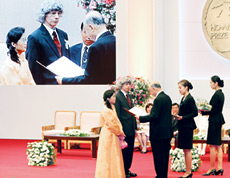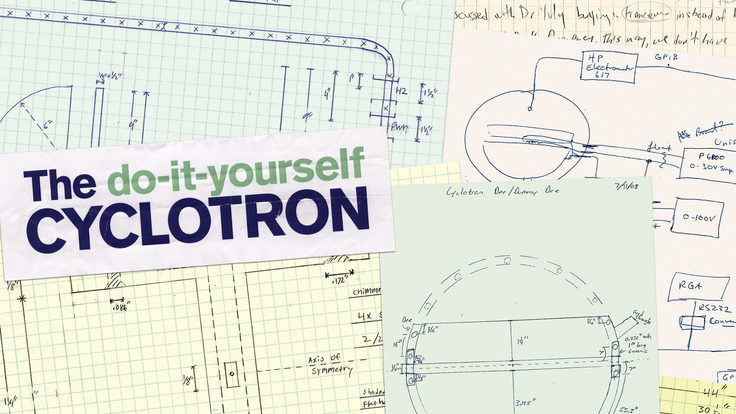
The rise of HEP in Korea
by Kurt Riesselmann
Forty years ago, Korea was a poor country with low per capita income, considered a developing nation by the rest of the world. Things have changed–enormously. Today, Korea is an industrial powerhouse; its 50 million citizens are recognized for the production of cars and electronic goods.
Korean physicists are making plans to add their efforts in high-energy physics (HEP) to the country's future list of accomplishments.
"Individuals are being recognized for their achievements in particle physics," says University of Chicago physicist Young-Kee Kim. "It is time for the country to be recognized."
Young-Kee Kim, designated deputy director of Fermi National Accelerator Laboratory, is one of the Korean particle physicists whose achievements have made her a celebrity at home. In 2005, she was the first woman to win the prestigious Korean Ho-Am award in the category of science, an honor that also entailed a US$200,000 cash prize.
Four decades ago, nobody could have imagined this progress. The first steps of particle physics were taken by physicists such as Benjamin Lee and Joo Sang Kang, who went to the United States. While Lee went on to become the head of the Fermilab Theory Department in 1973, Kang returned to Korea in 1981. He established a collaboration with scientists at the Japanese laboratory KEK who were in the process of building the tristan accelerator, the world's most powerful electron-positron collider when operations began in 1986.
Kang and his students joined the AMY collaboration, a group of about 100 scientists who built and operated a high-resolution particle detector to record the collisions produced by the tristan machine. The collaboration included about 20 institutions from four countries: Japan, the United States, China, and Korea.
"We produced so many good physicists," says Kang, professor at Korea University. "Young-Kee is only one of them." Young-Kee Kim, who had obtained a master's degree under the supervision of Kang, was one of the first students to join the AMY collaboration, working as a PhD student for the University of Rochester.
"This was a historic moment for Korea, sending students to work on AMY," remembers Young-Kee Kim.
 |
| Joo Sang Kang (right, shown with Sun Kun Oh) has played a key role in getting Korean scientists involved in particle physics experiments abroad. |
| Photo courtesy of Sun Kee Kim |
 |
| Dressed in traditional Korean style, Young-Kee Kim receives the Ho-Am award in June 2005. Established by Samsung chairman Kun-Hee Lee, the Ho-Am award annually recognizes five individuals who have made outstanding contributions to science, engineering, medicine, the arts, or community service. |
| Photo: Sam Sung |
Since then, Korean physicists have greatly expanded their international collaboration, with physicists trained abroad returning to Korea. From KEK (Japan) to DESY (Germany) to CERN (Switzerland) to Fermilab and SLAC (United States), Korean scientists are involved in the large-scale collider experiments that are taking place at the world's leading accelerator labora-tories. Correspondingly, the number of particle physicists working in Korea has increased significantly.
"Individually, these people are doing very well," says Kang. "But at the national level, we don't have much infrastructure to support them."
In Korea, funding for particle physics is provided by both the Korean Science and Engineering Foundation (KOSEF, administered by the Ministry of Science and Technology) and the Korea Research Fund (KRF, administered by the Ministry of Education). But there is no national laboratory dedicated to particle physics, and the government provides no specific particle physics budget. Grants are provided to individual research groups, and the total amount of money spent on HEP can vary greatly from year to year, depending on the success of individual applications. KOSEF has provided continued support for international collaboration through the Center for High Energy Physics, hosted by Kyungpook National University and headed by Dongchul Son, but the budget is far below the funding level needed for all activities of the Korean HEP community. As a consequence, the current system neither allows for setting long-term priorities, nor for planning projects that require amounts of money larger than those awarded to individual groups.
Korean scientists try to change this situation. Last year, they formed the Association of Korean High Energy Physicists and held their first meeting, attended by about 80 people.
"We need to develop a roadmap for Korean high-energy physics and inform our government," says Kang, who envisions the establishment of an advisory panel that is similar to the High Energy Physics Advisory Panel in the United States, or to the panels in Japan.
At this first meeting, scientists elected Sun Kee Kim, of Seoul National University, as the president of the association and the chair of a committee of 10 scientists charged with writing a report.
"It's not a top-down approach," says Sun Kee Kim of the newly formed association. "The government didn't ask us to do this. We started it ourselves."
In April of this year, the association held its second meeting, giving scientists the opportunity to discuss present and future research projects, including the proposed International Linear Collider, a global multi-billion-dollar project that involves scientists from Asia, Europe, and the Americas.
"Korean scientists want to be part of the Linear Collider project. That is very clear," says Sun Kee Kim. "We also have very strong collaborations with other countries. There are many different projects that people are working on. The Linear Collider is a big project, and how to balance it with other projects is not clear."
Sun Kee Kim leads a collaboration of 20 scientists from several institutions that runs the Korea Invisible Mass Search experiment, a deep-underground experiment searching for weakly interacting massive particles (WIMPS). It is the first particle physics experiment located, and largely built, in Korea.
A second home-grown experiment, the Reactor Experiment for Neutrino Oscillations (RENO), is in the works.
"The Korean government has approved $9 million for RENO, which could take data in late 2009," says Soo-Bong Kim, of Seoul National University, who leads the RENO project. The experiment, which consists of two relatively small neutrino detectors, about 1.5 km apart and weighing 20 tons each, will search for a yet unmeasured neutrino oscillation parameter by observing antineutrinos emitted from the Yonggwang reactors in southwest Korea.

A major point of discussion among Korean physicists is the creation of a National Laboratory for High Energy Physics, which would provide the means for planning, developing, and building major components for accelerator or detector projects.
"It may not be easy to build a high-energy accelerator, but at least we need a lab for R&D and mass production," Kang explains. "Our dream is that we will take charge of some subcomponent and build it. We have the capability, but we don't have the infrastructure yet."
If the dream becomes reality, it will bring Korea as a nation a step closer to the recognition it deserves.
Click here to download the pdf version of this article.






